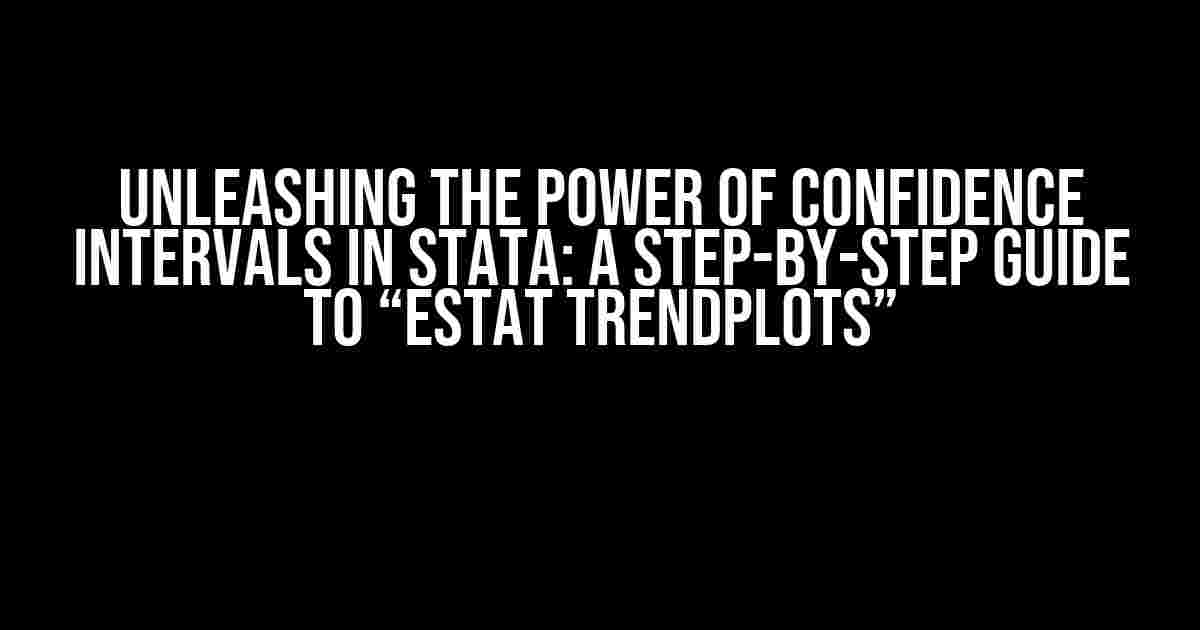Are you tired of staring at a sea of regression coefficients, wondering how to visualize the uncertainty surrounding your estimates? Do you want to take your data analysis to the next level by incorporating confidence intervals into your trend plots? Look no further! In this article, we’ll delve into the world of Stata’s “estat trendplots” command and show you how to make confidence intervals appear like magic.
The Problem: Missing Confidence Intervals
After running the “xtdidregress” command in Stata, you’re left with a sense of accomplishment, but also a hint of disappointment. Your trend plots are lacking a crucial element – confidence intervals. Those pesky intervals are nowhere to be found! But fear not, dear reader, for we’re about to uncover the secrets to unlocking this feature.
Understanding the “estat trendplots” Command
The “estat trendplots” command is a powerful tool in Stata’s arsenal, allowing you to visualize the relationship between your predictor variables and the outcome variable. However, by default, it only displays the point estimates, leaving out the confidence intervals. But why is that?
The reason lies in the way Stata handles the output of the “xtdidregress” command. When you run “xtdidregress”, Stata stores the results in memory, but it doesn’t automatically carry over the confidence intervals to the “estat trendplots” command. Ah, but there’s a way to coax those intervals out of hiding!
The Solution: Unleashing Confidence Intervals
To make confidence intervals appear in your trend plots, you’ll need to take a few extra steps. Don’t worry, it’s easier than you think!
Step 1: Store the Regression Results
First, store the results of your “xtdidregress” command using the “estimates store” command. This will allow you to retrieve the confidence intervals later.
xtdidregress depvar indepvars
estimates store myregStep 2: Retrieve the Confidence Intervals
Next, use the “estat ci” command to retrieve the confidence intervals for your regression coefficients. The “ci” option stands for “confidence intervals”, and it’s the key to unlocking this feature.
estat ci, level(95)Note that the “level(95)” option specifies the confidence level, which is set to 95% by default. You can adjust this value according to your needs.
Step 3: Create the Trend Plot with Confidence Intervals
Finally, use the “estat trendplots” command, but this time, add the “cis” option to include the confidence intervals.
estat trendplots, cis(myreg) plotopts(graphregion(fcolor(white)) scheme(s2color))The “cis(myreg)” option tells Stata to use the confidence intervals stored in “myreg” (from Step 1). The “plotopts” option customizes the appearance of the graph, but you can adjust these settings to your liking.
The Result: Confidence Intervals Galore!
Voilà! Your trend plot now displays confidence intervals around the point estimates, giving you a better understanding of the uncertainty surrounding your regression coefficients.
| Without Confidence Intervals | With Confidence Intervals |
|---|---|
As you can see, the confidence intervals add a layer of depth to your trend plots, allowing you to visualize the range of plausible values for your regression coefficients.
Tips and Variations
Now that you’ve mastered the art of adding confidence intervals to your trend plots, here are some additional tips and variations to take your analysis to the next level:
- Customize the appearance of your graphs**: Experiment with different graph schemes, colors, and fonts to create a visually appealing plot.
- Change the confidence level**: Adjust the confidence level to suit your research needs, such as 90% or 99%.
- Include multiple confidence intervals**: Use the “cis” option to include confidence intervals for multiple regression coefficients or models.
- Use other graphical options**: Explore other graphical options, such as scatter plots, box plots, or histograms, to visualize your data.
Conclusion
By following these simple steps, you’ve unlocked the secret to displaying confidence intervals in your “estat trendplots” command. No longer will you be limited by the default point estimates – now you can showcase the uncertainty surrounding your regression coefficients with confidence (pun intended)!
Remember, confidence intervals are an essential component of statistical analysis, providing a range of plausible values for your estimates. By incorporating them into your trend plots, you’ll gain a deeper understanding of your data and make more informed decisions.
So, go ahead and unleash the power of confidence intervals in your Stata analysis. Your data (and your readers) will thank you!
Frequently Asked Question
Get ready to boost your Stata skills and master the art of confidence intervals with “estat trendplots” command!
How do I get confidence intervals to appear when using the “estat trendplots” command in Stata after running “xtdidregress”?
You can use the “ci” option with the “estat trendplots” command to get confidence intervals. For example: estat trendplots, ci. This will display confidence intervals along with the trend plots.
What if I want to customize the appearance of the confidence intervals in the trend plots?
You can use various options with the “estat trendplots” command to customize the appearance of the confidence intervals. For example, you can use the “ciopts” option to change the color, style, and width of the confidence intervals. For instance: estat trendplots, ci ciopts(color(red) lpattern(dash) lwidth(thick)).
Can I specify the level of confidence for the intervals?
Yes, you can use the “level” option to specify the level of confidence for the intervals. For example: estat trendplots, ci level(95). This will display 95% confidence intervals in the trend plots.
How can I save the trend plots with confidence intervals to a file?
You can use the “graph save” command to save the trend plots with confidence intervals to a file. For example: graph save trendplot, replace. This will save the graph to a file named “trendplot.gph” in the current working directory.
Are there any other options available for customizing the trend plots with confidence intervals?
Yes, there are many other options available for customizing the trend plots with confidence intervals. You can use various options such as “xlabel”, “ylabel”, “title”, “legend”, and more to tailor the appearance of the graph to your needs. For example: estat trendplots, ci xlabel(“Time”) ylabel(“Outcome”) title(“Trend Plot with 95% CI”).
